Upper Mustang Trek in July- Are you ready to embark on a journey that will take you to one of the most remote and enchanting regions of the Himalayas? If so, then let me introduce you to the Upper Mustang trek, a thrilling adventure that will transport you back in time to a land that has remained untouched by the modern world. And what better time to experience this mystical land than in the month of July, during the monsoon season, when the mountains are alive with cascading waterfalls and the air is filled with the sweet scent of blooming wildflowers.

As you make your way through the rugged terrain of Upper Mustang, you’ll discover a world of ancient caves, towering cliffs, and hidden valleys. You’ll meet friendly locals who have preserved their traditions and way of life for centuries, and you’ll be awed by the colorful prayer flags that flutter in the wind offering prayers for your safe journey.
So pack your bags and get ready to experience the ultimate adventure in one of the most remote and captivating regions of the world. The Upper Mustang trek in July during the monsoon season is a journey you’ll never forget.
Weather Conditions and Temperature
July is considered to be the monsoon season in Nepal, but as Upper Mustang falls in the rain shadow area of the Himalayas, it experiences much less rainfall compared to the rest of the country.
In July, the temperature in Upper Mustang ranges from 10°C to 25°C during the day and can drop to 5°C to 10°C at night. The weather is generally warm during the day, but it can get cold at night.
Also Read: Upper Mustang Trek in June: Travel Tips, Weather, and More
Despite being a monsoon season, Upper Mustang receives very little rainfall in July. The average rainfall is around 20 mm, making it a perfect time to visit for those who prefer less rainfall. The region’s unique geography creates a rain shadow effect, which means that the mountains block the monsoon clouds, resulting in dry and clear weather.
Highlights of the Upper Mustang Trek in July
Trekking in Mustang during July can be a unique and memorable experience, although it is monsoon season. Here are some highlights of the Upper Mustang trek in July:
Off the beaten path:
Upper Mustang is a restricted region of Nepal, and it is one of the few remaining areas in the world where you can still see the original Tibetan culture. The region is not as popular as other trekking destinations in Nepal, so you can experience a more peaceful and less crowded trek.
The Lo Manthang:
The main attraction of the Upper Mustang trek is the ancient walled city of Lo Manthang. It is a beautiful and historic city that was once the capital of the Mustang Kingdom.
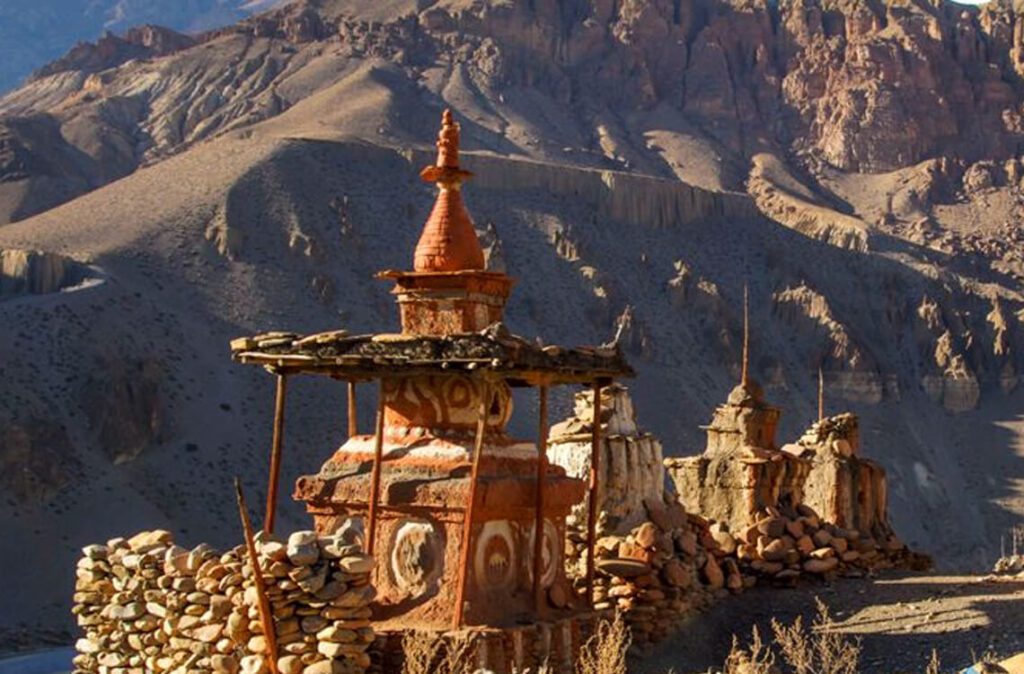
The city is home to some of the oldest and most well-preserved Buddhist monasteries and temples.
Unique landscape:
Upper Mustang is known for its unique desert-like landscape which is quite different from the lush forests and greenery found in other trekking destinations in Nepal. The region’s rugged terrain is made up of sandstone cliffs, deep canyons, and barren mountains.
Rich culture:
The Upper Mustang region has a rich and diverse culture, heavily influenced by Tibetan Buddhism. You will see beautiful chortens, prayer flags, and ancient monasteries along the trekking trail. Moreover, you will have the opportunity to interact with the locals and learn about their unique way of life.
Challenging trekking route:
The Upper Mustang trek is a challenging trekking route, and it requires a good level of fitness and endurance. The trek is at a high altitude, and the terrain is rugged and uneven. However, the stunning views and unique experience make it all worthwhile.
Authentic local cuisine:
The Upper Mustang region has its own unique cuisine, which is a fusion of Tibetan and Nepali flavors.
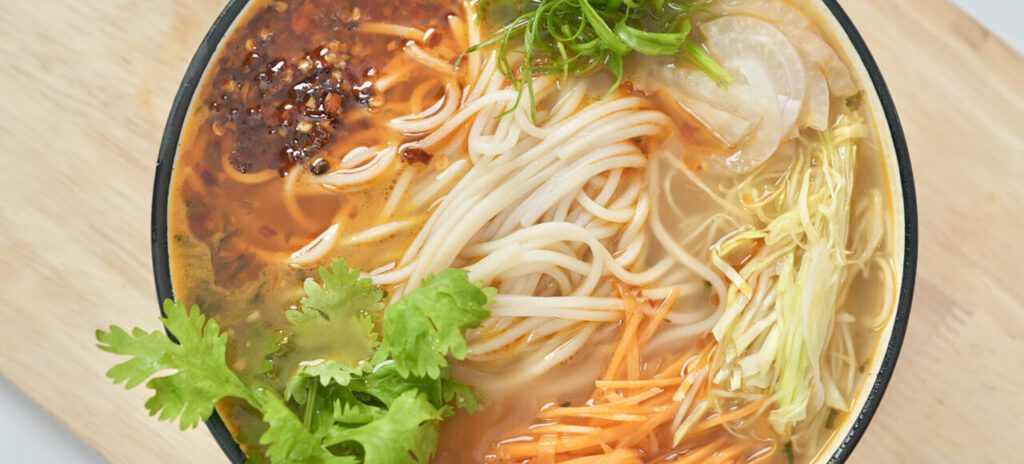
You can try local dishes like Thukpa (noodle soup), momos (dumplings), and yak meat, which are hearty and delicious.
Stunning mountain views:
The Upper Mustang trek offers breathtaking views of some of the world’s highest mountains, including Dhaulagiri, Annapurna, and Nilgiri. The monsoon clouds add to the dramatic scenery and create stunning photo opportunities.
How to Travel to Upper Mustang From Kathmandu
The most common way to reach Upper Mustang from Kathmandu is by air or by road. Here are some of the ways to get to Upper Mustang from Kathmandu:
By Flight:
There is no direct flight from Kathmandu to Upper Mustang. The most common way to reach Upper Mustang is by taking a connecting flight from Kathmandu to Jomsom, which is the gateway to Upper Mustang.
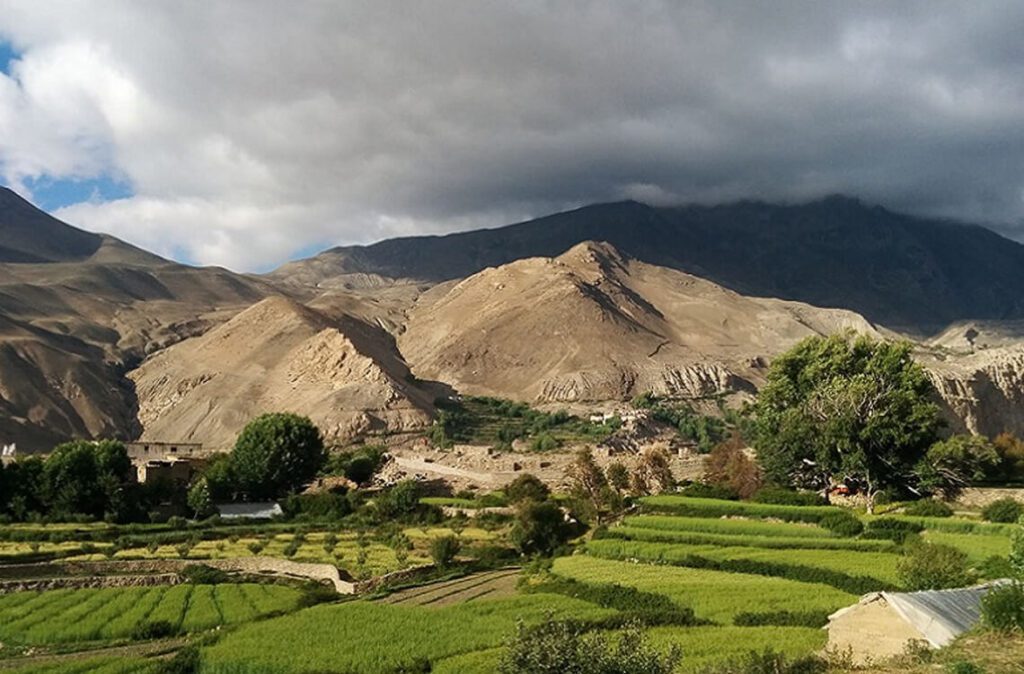
The flight takes about 20-25 minutes and offers stunning views of the Himalayan range, including Dhaulagiri and Annapurna. From Jomsom, you can hire a jeep or trek to Upper Mustang. The road from Jomsom to Upper Mustang is rough and dusty, and the journey can take anywhere from a few hours to a day, depending on the mode of transport and the weather conditions.
By Private Jeep:
Another option for reaching Upper Mustang is by hiring a private jeep. This is a comfortable and convenient way to travel, particularly if you’re traveling with a group or have a lot of luggage. It can also be faster than traveling by public bus, as you can make stops and take breaks whenever you want. The cost of hiring a private jeep varies depending on the route and the number of passengers.
By Public Bus:
If you’re on a tight budget, traveling by public bus is the cheapest option for reaching Upper Mustang. However, it’s not the most comfortable or convenient option as the journey can take a long time and the buses can be crowded and uncomfortable.
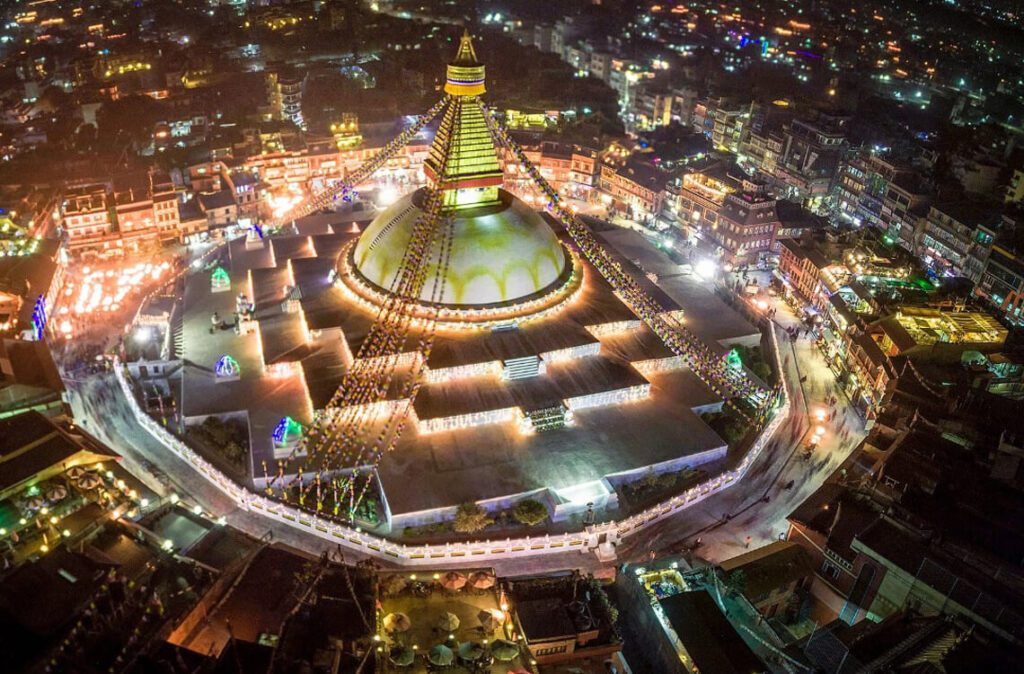
The route from Kathmandu to Upper Mustang is particularly rough and bumpy so be prepared for a challenging ride.
By Renting a Motorbike:
Renting a motorbike is another popular option for traveling to Upper Mustang. This gives you the freedom to explore the region at your own pace and take detours off the main road. However, it’s important to note that the road from Kathmandu to Upper Mustang is rough and challenging, so you need to be an experienced rider and have a sturdy bike.
Required Permit for the Upper Mustang Trek
To trek in the Upper Mustang, you need to obtain a special permit called the “Restricted Area Permit” from the Government of Nepal. As the name suggests, Upper Mustang is a restricted area; consequently, a permit is required to preserve its unique culture and environment.
Moreover, you must provide a copy of your passport, along with a passport-sized photograph, and pay the necessary fees to obtain the permit. As of 2021, the cost of the permit is USD 500 per person for the first 10 days, with an additional USD 50 per day for each extra day.
You may also like: Upper Mustang Trek in May: Weather, Difficulty Travel Tips, and More
In addition to the Restricted Area Permit, you also need to obtain the Annapurna Conservation Area Permit (ACAP), which costs USD 30 per person, and a TIMS (Trekkers’ Information Management System) card, which costs USD 20 per person. Both permits can be obtained from the Nepal Tourism Board in Kathmandu or Pokhara or from the entry checkpoint of the Annapurna Conservation Area.
Flora and Fauna
In July, the monsoon season in Nepal is in full swing, and the Upper Mustang region can be a bit challenging to trek due to the rain and muddy trails. However, the region’s flora and fauna come to life during this time, providing a unique experience for nature lovers.
Flora
In July, the Upper Mustang region experiences rainfall which encourages the growth of various plants and flowers. The following are some of the flora that can be spotted during this time:
Apple trees:
Apple trees can be found in Upper Mustang in July. These trees are cultivated in the region and are known for their delicious and juicy fruits. They grow in orchards and their blossoms can be seen in the spring season.
Buckthorn trees:
Buckthorn trees are a common sight in Upper Mustang in July. These trees grow at lower elevations and are known for their thorny branches and small yellow flowers. They provide food and shelter to a variety of animals in the region.
Juniper trees:
Juniper trees are a type of coniferous tree that can be found in Upper Mustang in July. These trees grow at high altitudes and are adapted to the cold and arid climate of the region. They are known for their twisted trunks and blue-green needles, which have a strong fragrance.
More: Upper Mustang Trek in April: Weather, Difficulty Travel Tips, and More
Willow trees:
Willow trees can be found in Upper Mustang in July. These trees grow along the rivers and streams in the region and are characterized by their slender trunks and long, narrow leaves. They provide shade and shelter to a variety of animals in the region.
Pine trees:
Pine trees are a common sight in Upper Mustang in July. These trees grow in the lower elevations of the region and can be seen along the trekking trails. They are known for their tall and straight trunks and their needles can range from green to blue-green.
Himalayan Primrose:
The Himalayan Primrose is a beautiful alpine flower that can be seen in Upper Mustang in July. These flowers are known for their delicate petals which range from pink to purple, and are adapted to grow in rocky environments. They grow at high altitudes and can be seen along the trekking trails in the region.
Fauna
There are various animals that one can expect to encounter during the Upper Mustang trek, including:
Yak:
One of the most iconic animals that you may encounter during the Upper Mustang trek is the Yak. Yaks are large, shaggy-haired, domesticated bovines that are commonly used as pack animals in the Himalayas.
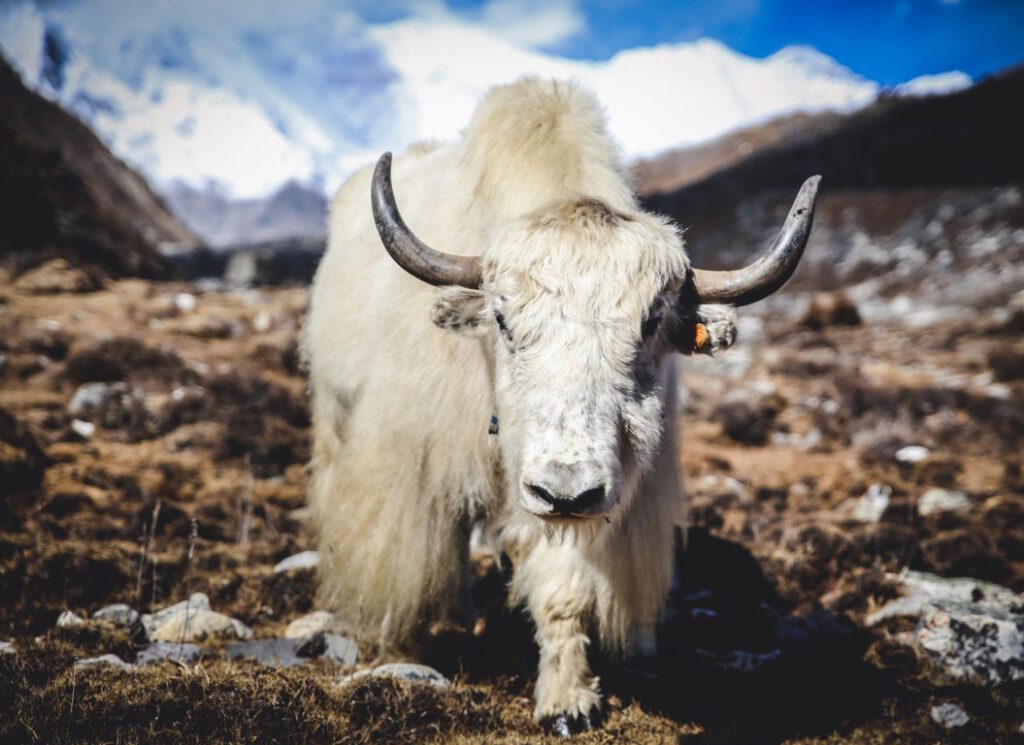
They can carry heavy loads of equipment and supplies for long distances making them an essential part of mountain trekking expeditions.
Blue Sheep:
Another common animal that you may see on the Upper Mustang Trek is the Blue Sheep. Also known as the Bharal, Blue Sheep are a species of wild sheep that inhabit the rocky mountain slopes and grassy meadows of the Himalayas. They are known for their distinctive blue-gray coat and curved horns.
Himalayan tahr:
The Himalayan Tahr is another species of wild sheep that can be spotted during the Upper Mustang Trek. These animals are characterized by their thick, woolly coat, which protects them from the cold temperatures of the mountainous environment. They are agile climbers and are often seen perched on steep rock faces.
Snow leopard:
Snow Leopard, one of the most elusive and iconic predators of the Himalayas, also inhabits the Upper Mustang region, but it is very rare to spot one.

These majestic big cats are highly endangered, and their population is declining due to habitat loss and poaching.
Tibetan Argali:
The Tibetan Argali is well-adapted to the harsh and arid environment of the Himalayan mountains, where they feed on grasses, herbs, and shrubs. They are known for their keen eyesight and acute sense of hearing which help them detect predators and other potential threats.
Other animals that may be seen during the Upper Mustang trek include Himalayan Black Bears, Langur Monkeys, and a variety of bird species such as Tibetan Snowcocks, Himalayan Griffons, and Lammergeiers.
Side Treks
During the Upper Mustang trek in July, there are several side treks that you can take to explore the surrounding areas. Here are some of the favorable side treks that you can consider:
Lo Gekar Monastery Trek:
This is a short trek that takes you to the Lo Gekar Monastery, which is one of the oldest monasteries in Nepal. The trek offers stunning views of the surrounding mountains and landscapes and takes around 4-5 hours to complete.
Popular: Upper Mustang Trek in March: Travel Tips, Weather, and More
Choser Cave Trek:
This trek takes you to the Choser Cave, which is an ancient cave system that was used by the people of the Upper Mustang as a shelter and storage space. The cave is located near the village of Choser and can be reached within 2-3 hours from the main trail.
Dhakmar Trek:
This is a scenic trek that takes you to the village of Dhakmar, which is famous for its red cliffs and stunning landscapes. The trek offers spectacular views of the surrounding mountains and landscapes and takes around 4-5 hours to complete.
Lo Manthang:
Lo Manthang is a walled city that was once the capital of the ancient Kingdom of Lo, and it is home to many historic and cultural landmarks. Some of the main attractions in Lo Manthang include the Royal Palace, the Jampa Lhakhang Temple, the Thubchen Gompa, and the Chodey Monastery.

These sites offer a glimpse into the rich history and culture of the region, and they are a testament to the enduring legacy of the Kingdom of Lo.
Muktinath temple:
Muktinath is a sacred site for both Hindus and Buddhists, and it is located at an altitude of 3,710 meters. The site is home to a temple complex that houses a natural spring and 108 water spouts.
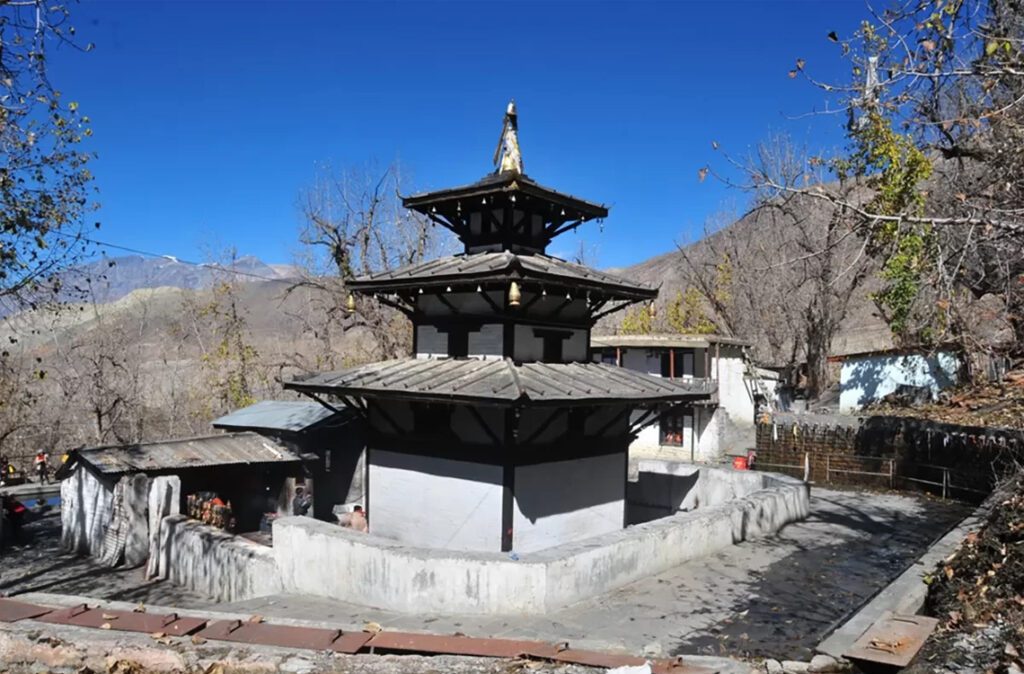
The temple is dedicated to Lord Vishnu and is believed to be a place of liberation or moksha for Hindus.
Difficulty Level of the Upper Mustang Trek in July
The Upper Mustang region lies in the rain shadow area, which receives less rainfall than other parts of Nepal. However, there is still a chance of precipitation, especially in the lower elevations. You should be prepared to deal with muddy trails and the possibility of getting stuck in the rain.
The Upper Mustang Trek also involves trekking through high-altitude areas which can be physically demanding and require proper acclimatization.
The highest point of the trek is the Lo La Pass (3950m). It demands a steady ascent and a good level of fitness. You might also encounter symptoms of altitude sickness, like headaches, dizziness, and nausea. These can be managed by taking sufficient rest and staying hydrated.
Tips for the Upper Mustang Trek in July
The Upper Mustang trek in July can be challenging due to the monsoon season but with the right preparation and planning, you can still have a wonderful experience. Here are some tips to help you make the most of your Upper Mustang trek in July:
Bring proper gear:
Make sure you have the right gear for monsoon weather. This includes waterproof hiking boots, a rain jacket, rain pants, and a waterproof backpack cover.
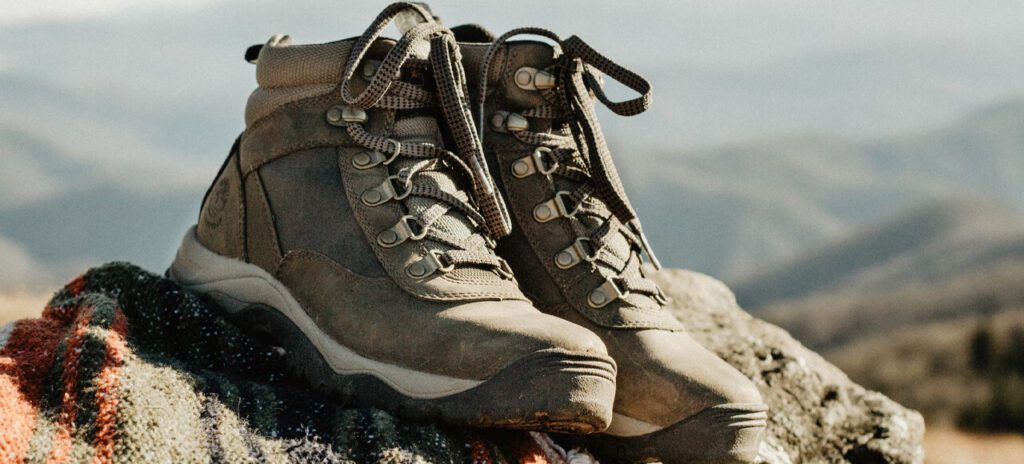
Also, pack warm clothing for cold nights.
Be prepared for flight delays:
Flights to and from Jomsom, which is the starting point for the Upper Mustang trek, can be delayed or canceled due to bad weather. Therefore, plan to have some extra days in your itinerary to accommodate possible delays.
Stay hydrated:
Even though it is monsoon season, the weather can still be hot and humid. Be sure to drink plenty of water and carry a water bottle with you at all times.
Hire a guide:
It is highly recommended to hire a guide for the Upper Mustang trek, especially during the monsoon season. A guide can help you navigate the challenging terrain and can also provide you with valuable information about the local culture and customs.
Bring insect repellent:
Monsoon season also means more insects. Bring insect repellent to protect yourself from mosquitoes and other insect bites.
Bring enough cash:
Upper Mustang lacks ATMs and banks. Therefore, it’s crucial to carry sufficient cash for all expenses such as food, accommodation, transportation, and permits.







